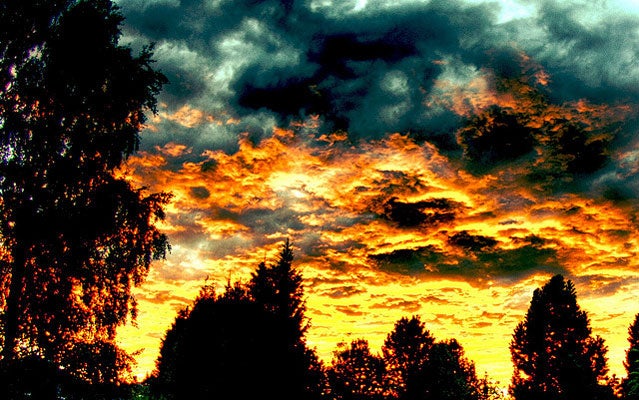The Extreme Survival Guide
The world is a weird place. You never know when you’ll be standing next to a lake as it releases a giant carbon-dioxide bubble that could asphyxiate you within minutes. Scoffing at that possibility? Well, scoffer, if you want to live your life at the whim of impending, improbable-but-not-completely-one-hundred-percent-impossible disasters, that’s your call. But don’t look at me when you’re being eaten by a zombie outside of a 7-11, because it will definitely happen.
If you’re not a skeptic/scoffer/someone who refuses to see that apocalypse movie with John Cusack, then we’re here for you. We’ve spoken to experts and gotten the low-down on how to survive some of the most extreme scenarios on Planet Earth. Read on and thank us later. There is no time for anachronistic pleasantries when you’re about to be engulfed by lava, anyway.
- Stuck in a Desert
- Piranha Attack
- Volcano Eruption
- Lake Releases CO2 Bubble
- Cannibalism
- Zombie Apocalypse
Extreme Survival: Stuck in a Desert
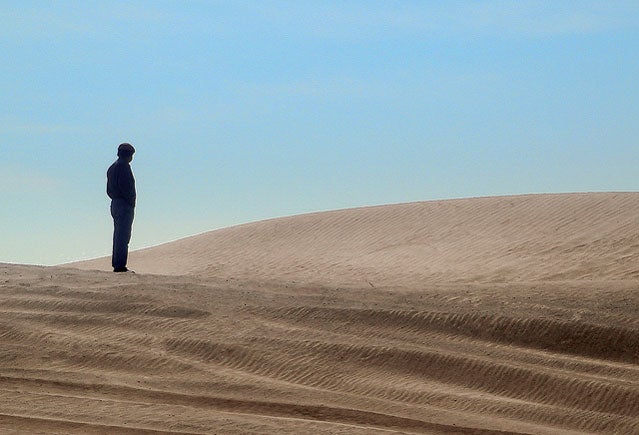
THE SITUATION: For whatever reason—plane crash, misguided hike, scavenger hunt gone horrifically wrong—you’re stranded in a desert. You have no food. You have nothing to drink. If you don’t do anything, you will die, eventually. You don’t want to die, though.��
WHAT DO YOU DO? First, you should find some shade and make sure you’re not dehydrating. Then, you should figure out what kind of desert you’re in. “Do a quick survey in your head and say ‘OK what do I see here? What’s available?’” says Jesus M. Garcia, education director at the . “Maybe it’s sand dunes. In those environments there are plants that are tubers, and they have big, succulent roots you could actually dig out and mush and get moisture out of them.” If you can, look for what animals eat and follow their example. “There might be some things that are edible and good to eat, but you’ve never tasted them in your life—and they might taste horrible to you.”
To find water, look for arroyos or depressions in rocks where moisture might collect. More than anything, it’s about staying calm and figuring out where you are. “You start by assessing your environment and not just hoping you’re going to find something right away,” Garcia says.
Extreme Survival: Piranha Attack
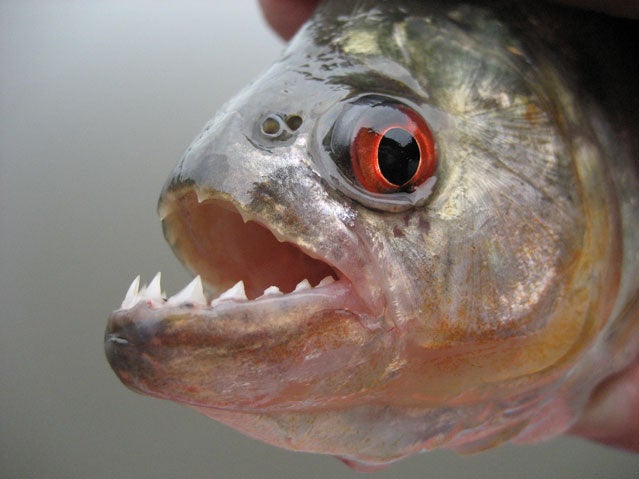
THE SITUATION: You’re swimming in the Amazon, when somehow you get a cut. Suddenly, a school of piranhas start to swarm you. While they might not actually attack and de-bone humans for fun, they can still get agitated when they smell blood. Unfortunately, it’s now your blood, and you’re being attacked. It’s starting to hurt—their teeth are pretty sharp—and you want to get away.��
WHAT DO YOU DO? You’re probably best served by following your instincts, which hopefully tell you to get the hell out of there.��
“This answer is going to sound sarcastic, but it is not: get out of the water,” says Christopher Pomory, biology professor at the University of West Florida. “Hollywood movies have greatly overdone the danger. Piranhas can form into feeding frenzies on occasion, so some of the hype is real and it usually comes from blood in the water.”
Although the 3-D glasses definitely made seem like the realest thing ever—wait, you didn’t see it? No one saw it? Well, your loss, but anyway, the film was basically pure fantasy. Still, the fish can be dangerous, like all things that get hungry and have fangs.
“People in South America swim in water with them all the time without any trouble. If someone is injured and blood gets into the water, and if enough fish are around that respond, then there is a possible danger,” says Pomory. “The only way out of it is to leave the water. At that point you are treating a flesh wound.”
Extreme Survival: Volcano Eruption
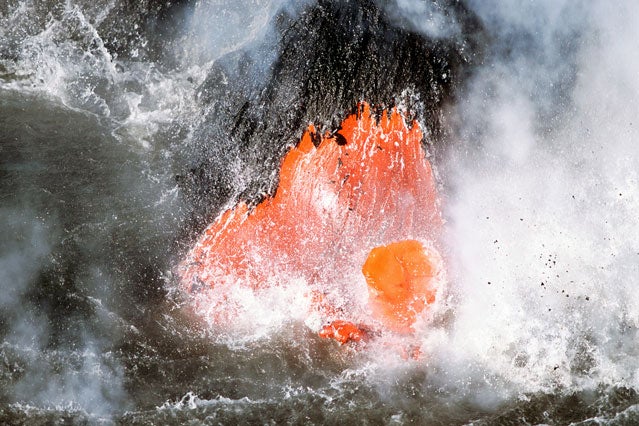
THE SITUATION: For some reason, you find yourself within striking distance of an active volcano. Then, it erupts. It’s coming, and it’s coming fast—too fast for you to outrun the flow. Luckily, you’re not completely doomed.��
WHAT DO YOU DO? Before making your escape, you need to figure out what find of flow you’re dealing with, says Greg Valentine, a geology professor at the University of Buffalo.��
“The first one is a lava flow. What you see in video of Hawaii with these rivers of lava flowing down the volcano,” says Valentine. “Your best bet is to go uphill or climb some structure that’s above the flow. The lava’s gonna stay in the low ground.”
For the other kind—pyroclastic flow, a mixture of hot gases and particles that travels at about a hundred yards per second and can reach hundreds of degrees in temperature—you’ll want to do the exact opposite. “With these, your best bet is to go underground, into a basement,” Valentine says. “There was a famous eruption on the island of Martinique very early in the 20th century, where a whole city was destroyed. Everyone died except for a few people, one of whom was a prisoner in a dungeon.”
So why high ground for lava and below ground for pyroclastic?
“[Pyroclastic flows] move at a very high speed and are often hundreds of feet high, so when it hits you, it can be greater than hurricane-force winds. They’re full of debris, rocks, and pieces of buildings, too,” says Valentine. “You want to be underground somewhere that’s like a bomb shelter, protected from the heat, protected from the force of the flow. If you were underground in a basement and a lava flow went over you, you’d be safe, I guess, but you wouldn’t be able to get out. When a lava flow cools it makes solid rock, so you’d be trapped.”
Extreme Survival: Lake Releases CO2 Bubble
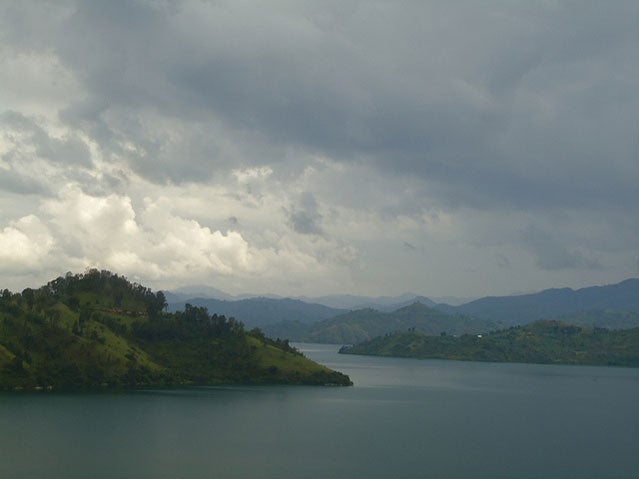
THE SITUATION: In 1986, around 1,700 people died in a Cameroonian village when stored in its water. Two years before, Lake Monoun, another Cameroonian lake, released a toxic cloud that killed 37 people. Now, you’re somewhere near Lake Kivu, a third Cameroonian lake that doubles as a reserve for carbon dioxide and methane. Except, due to some recent volcanic activity, those gases are suddenly being released into the air, which you need to breathe in order to continue living.��
WHAT DO YOU DO? The higher you can get yourself, the better. “There isn’t much scientific analysis to back this up,” says Professor Anthony Vodacek of the Rochester Institute of Technology, “more just common sense. One would want to keep the quads in good shape and head straight uphill—and there are generally plenty of hills along the shore of Lake Kivu.”��
Professor Robert Hecky of the University of Minnesota Duluth echoes Vodacek’s advice. “The most certain danger would be asphyxiation, as the CO2 is heavier than the air and would tend to spread laterally over the lake and nearby land. The best advice is to head for high ground trying to stay above the layer of CO2 which would slowly be mixed into the overlying atmosphere.”��
In addition to the poisonous air and a possible volcanic eruption (which you’re already set with), the rising gases would also probably cause a giant tsunami-like wave in the lake, so you’d have that to deal with, too. “The survival strategy is the same: head for high ground,” Hecky says.
Extreme Survival: Cannibalism

THE SITUATION: You’re shipwrecked on a desert island, without any food or the equipment and energy to gather it. You were with a friend, but he/she just died. If you don’t find something to eat soon, you will die. Then, you realize there’s a body next to you. Oh God.
BUT SERIOUSLY, WHAT DO YOU DO? For that answer, we turn to Carole A. Travis-Henikoff, author of .��
“If you happen to be a Navy SEAL or were trained in extreme survival tactics by the Armed Forces, you would know that your survival depended on quick and immediate action; you would know that you have no time for grieving or panic.” You don’t have much time to spare, especially if you’re in warmer climes: “On a small, warm-to-hot island a body soon decays and becomes inedible.”
OK, brace yourself and maybe be near a garbage pail.
“First, find some palm leaves or washed-up boards. Cut open the abdomen and eviscerate the body, emptying the body cavity completely while saving the liver, but not the bile duct,” Travis-Henikoff says. Wash the body thoroughly using seawater and get it and the liver into the shade.
You’ll want to start by eating the liver and remaining organs. “The most nutritious parts of any mammalian body are the organs,” says Travis-Henikoff. If possible, make a fire and cook the heart, liver, and brain, which have the most calories, vitamins, and minerals, and will also spoil first. Cook the muscle next. Leftover meat will last for a few days if you rub it with sea salt, wrap it, and store it “off the ground in a well-shaded place.”
Your best bet for preserving the remaining uncooked muscle is to make jerky. “The muscle meat you dry will help you survive—make all the jerky you can,” advises Travis-Henikoff. Cut the muscle into very thin strips and hang it over a tree limb or pole in bright sunlight. Flies will swarm on the jerky at first, but once the outer layer is dry, it should keep for long enough to supply you with food until help arrives.
Then, you never eat another human being ever again.
Extreme Survival: Zombie Apocalypse

THE SITUATION: There is one certainty in life: at some point in the near future you will either become a zombie or you will have to fend off a horde of flesh-hungry ghouls that want to eat you. All of this other advice, you’ll probably never use any of it. But this, this is cold, hard reality. You should get the following information tattooed on your eyelids and probably (backwards) on your forehead, too.��
WHAT DO YOU DO? Matt Mogk, author of and founder of the , offers these five tips about surviving the zombie apocalypse:��
“1. Prepare or Perish: When the dead walk the earth, who perishes and who stays alive will largely be determined by how well they prepared before disaster struck. Do you have the tools, skills, and mental fortitude to survive over the long term if civilization collapses this instant? If not, you might want to think about making some changes, or you risk starving to death or being eaten alive by what used to be your dear friends and family.”
“2. Stay Local to Stay Alive: All zombie survival is local. The fantasy of traveling hundreds of miles to an ideal location in an unfamiliar city, town, or wilderness region is just that: a fantasy. Of course no matter how well stocked and fortified you are at home, chances are you’ll eventually find a compelling reason to hit the road. But until then, every mile you venture outside of your comfort zone reduces your chances of survival.”
“3. Keep Your Head Up: Maintaining a positive mental attitude in a catastrophic undead outbreak is just as vital to your survival as having essential gear and supplies. Depression and despair already cause harmful effects in tens of millions of people worldwide. In a zombie pandemic, these same mental obstacles will often be the difference between life and death. Unless you keep your mind right, all the fitness, preparation, and know-how in the world will do you no good.”
“4. Follow the Rule of Three: This established survivalist principle holds that in a worst-case scenario, a person can live only so long without certain essentials. In three minutes, you’re dead without air. In three hours, you’re dead without shelter. In three days, you’re dead without water. In three weeks, you’re dead without food. Remember the rule of three in the aftermath of a zombie outbreak or when trying to survive any other more common catastrophic natural or man-made disaster.”
“5. Stay Away From People: There’s a lot we still don’t know about, but one key ingredient is obvious: people. Without people, there can be no walking dead trying to hunt and kill other people. This seems like a simple concept, but it’s too often overlooked when developing survival strategies for a zombie outbreak. The best advice for increasing your odds of staying alive is to keep away from people.”
You’re welcome.


